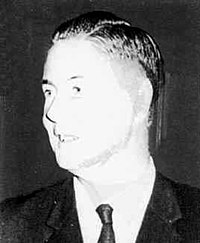Johannes De Groot
| Johannes de Groot | |
|---|---|
 |
|
| Born |
7 May 1914 Garrelsweer, Loppersum, Groningen |
| Died | 11 September 1972 (aged 58) Rotterdam, Netherlands |
| Nationality | Netherlands |
| Fields | Topology |
| Institutions | Centrum Wiskunde & Informatica, Delft University of Technology, University of Amsterdam |
| Alma mater | Rijksuniversiteit Groningen |
| Doctoral advisor | Gerrit Schaake |
Johannes de Groot (May 7, 1914 – September 11, 1972) was a Dutch mathematician, the leading Dutch topologist for more than two decades following World War II.
De Groot was born at Garrelsweer, a tiny village in the municipality of Loppersum, Groningen, on May 7, 1914. He did both his undergraduate and graduate studies at the Rijksuniversiteit Groningen, where he received his Ph.D. in 1942 under the supervision of Gerrit Schaake. He studied mathematics, physics, and philosophy as an undergraduate, and began his graduate studies concentrating in algebra and algebraic geometry, but switched to point set topology, the subject of his thesis, despite the general disinterest in the subject in the Netherlands at the time after Brouwer, the Dutch giant in that field, had left it in favor of intuitionism. For several years after leaving the university, De Groot taught mathematics at the secondary school level, but in 1946 he was appointed to the Mathematisch Centrum in Amsterdam, in 1947 he began a lecturership at the University of Amsterdam, in 1948 he moved to a position as professor of mathematics at the Delft University of Technology, and in 1952 he moved again back to the University of Amsterdam, where he remained for the rest of his life. He was head of pure mathematics at the Mathematisch Centrum from 1960 to 1964, and dean of science at Amsterdam University from 1964 on. He also visited Purdue University (1959–1960), Washington University, St. Louis (1963–1964), the University of Florida (1966–1967 and winters thereafter), and the University of South Florida (1971–1972). He died on September 11, 1972 in Rotterdam.
...
Wikipedia
